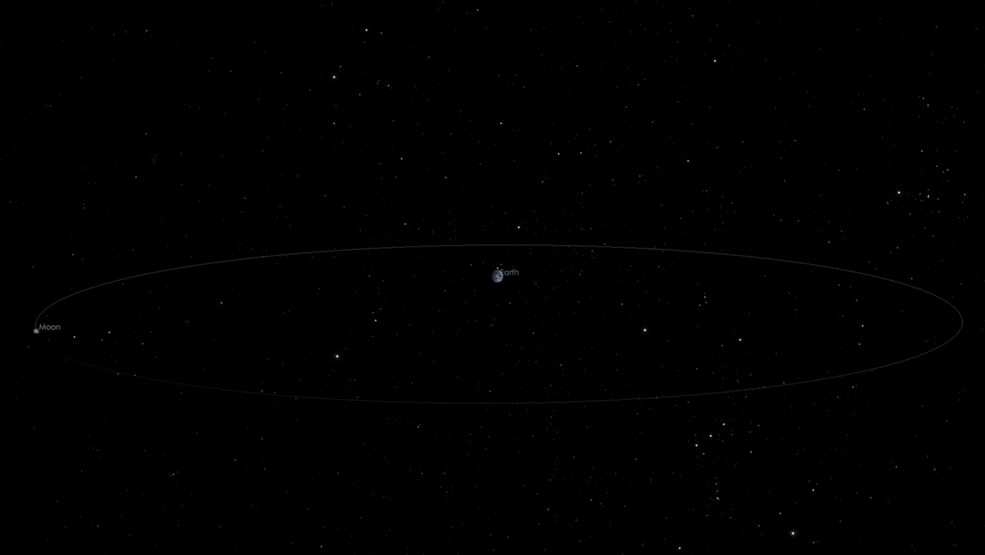A near-Earth asteroid the size of a bus will skim past our planet tomorrow at 11,600mph (18,700km/h) at just one third of the distance between us and the moon.
Asteroid 2018 DV1, which was only spotted on Monday, will brush past just 65,000 miles (105,000km) from the surface of our planet.
The asteroid has a diameter of between 20 to 40 feet (5.6 to 12 metres) and was only spotted days on Monday thanks to the world’s most powerful telescopes.
Now with a virtual telescope project people have a chance to see the small asteroid rocket past using a live webcast.
Asteroid 2018 DV1, which was first seen on Monday, will pass just 65,000 miles (105,000km) from the surface of our planet which is one third the distance to the moon (stock image)
Astronomers say this latest pass should not cause alarm and is the 18th known asteroid to fly within one lunar distance to our planet since the beginning of this year.
We are only hearing more about them bow because astronomers have got better at detecting them, writes Earth Sky.
Star gazers can view the 2018 DV1 as it skims past our planet using the 16-inch robotic telescope at the Tenagra Observatories in Arizona as part of the Virutal Telescope Project and Tenagra Observatories.
The webcast will begin at 12:30 a.m. EST (0530 GMT) tomorrow.
Earlier this month, a space rock, called 2018 CB, also blazed past at just one-fifth of the distance between our planet and the moon.
Astronomers say this latest pass should not cause alarm and is the 18th known asteroid to fly within one lunar distance to our planet sine the beginning of this year

With a diameter between 20 to 40 feet (5.6 to 12 metres) the rock (pictured) was only spotted thanks to the most powerful telescopes
The asteroid was between 50 and 130 feet (15 and 40 metres) wide and an expert warned that an asteroid of this size would only get this close to our planet ‘once or twice a year’.
It was first spotted by the Nasa-funded Catalina Sky Survey (CSS) near Tucson, Arizona.
‘Although 2018 CB is quite small, it might well be larger than the asteroid that entered the atmosphere over Chelyabinsk, Russia, almost exactly five years ago, in 2013,’ said Paul Chodas, manager of the Center for Near-Earth Object Studies at NASA’s Jet Propulsion Laboratory in Pasadena, California.
‘Asteroids of this size do not often approach this close to our planet – maybe only once or twice a year.’
However, not all asteroids do pass safety from our planet.
In February 2013 a 19-metre meter (62-feet) meteor exploded in the skies above Chelyabinsk in Russia.
The meteorite broke up into multiple pieces as it entered the atmosphere, scattering space debris and creating a shock wave estimated to be as strong as 20 Hiroshima atomic bombs.

Earlier this month, a space rock, called 2018 CB, also blazed past at just one-fifth of the distance between our planet and the moon
It caused a shock wave that smashed windows, damaged buildings and injured 1,600 people.
The energy – which was equivalent to 500,000 tonnes of TNT – and injured more than 1,000 people
Currently Nasa would not be able to deflect an asteroid if it were heading for Earth but it could mitigate the impact and take measures that would protect lives and property.
This would include evacuating the impact area and moving key infrastructure.
Finding out about the orbit trajectory, size, shape, mass, composition and rotational dynamics would help experts determine the severity of a potential impact.
However, the key to mitigating damage is to find any potential threat as early as possible.
Nasa is currently moving forward with a refrigerator-sized spacecraft capable of preventing asteroids from colliding with Earth. A test with a small, nonthreatening asteroid is planned for 2024.
This is the first-ever mission to demonstrate an asteroid deflection technique for planetary defence.
The Double Asteroid Redirection Test (DART) would use what is known as a kinetic impactor technique—striking the asteroid to shift its orbit.
The impact would change the speed of a threatening asteroid by a small fraction of its total velocity, but by doing so well before the predicted impact, this small nudge will add up over time to a big shift of the asteroid’s path away from Earth.
